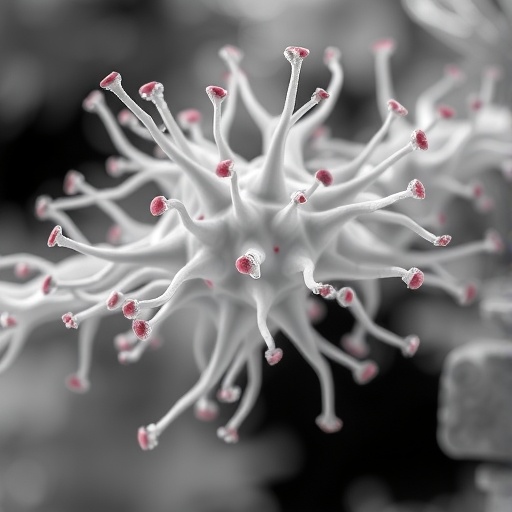
In a groundbreaking study published recently in Acta Parasitologica, researchers have unveiled the intricate biochemical landscape of a pivotal enzyme, NUDIX hydrolase, derived from the protozoan parasite Leishmania major. This pathogen, responsible for causing leishmaniasis—a complex disease with diverse clinical manifestations—has long intrigued scientists due to its sophisticated survival mechanisms within mammalian hosts. The detailed characterization of NUDIX hydrolase represents a significant leap forward in understanding the molecular underpinnings that facilitate parasite survival and virulence, opening new avenues for targeted therapeutic interventions.
The research team led by Jamdhade et al. embarked on an extensive biochemical and structural exploration of this enzyme, which belongs to the widespread NUDIX hydrolase superfamily. Members of this family are known for catalyzing the hydrolysis of nucleoside diphosphates linked to various moieties, playing crucial roles in cellular housekeeping, RNA metabolism, and the maintenance of nucleotide pool fidelity. However, the selective functions and nuances of NUDIX enzymes in parasitic protozoa have remained largely uncharted until now.
Using advanced cloning and recombinant protein expression techniques, the investigators successfully isolated the gene encoding the Leishmania major NUDIX hydrolase and expressed it in bacterial systems. Subsequent purification and enzymatic assays confirmed its activity profile and substrate specificity, revealing a distinctive preference for particular nucleotide diphosphate derivatives. This substrate activity pattern adds a new layer of understanding about how the parasite modulates nucleotide metabolism to counter oxidative stress and DNA damage during infection.
.adsslot_VJy8QBiKkg{width:728px !important;height:90px !important;}
@media(max-width:1199px){ .adsslot_VJy8QBiKkg{width:468px !important;height:60px !important;}
}
@media(max-width:767px){ .adsslot_VJy8QBiKkg{width:320px !important;height:50px !important;}
}
ADVERTISEMENT
Structurally, the enzyme exhibits conserved motifs characteristic of the NUDIX family, including the signature NUDIX box—a sequence crucial for coordinating metal ions necessary for catalysis. Through site-directed mutagenesis, the researchers identified key amino acid residues that govern enzymatic activity and stability, providing insight into the molecular architecture that controls the enzyme’s function. Such detailed mapping paves the way for rational drug design aimed at disrupting enzyme activity selectively in the parasite.
The team further explored kinetic parameters of the enzyme, such as Km and Vmax, under varying pH and temperature conditions mimicking the intracellular environment of the host macrophage. Notably, the enzyme demonstrated remarkable stability and efficiency at physiological temperatures and appeared optimized for operation within the oxidative milieu of the parasitophorous vacuole. This adaptive functionality underscores the parasite’s evolutionary fine-tuning of enzymatic systems to thrive within hostile host compartments.
By investigating the enzyme’s response to potential inhibitors and metal cofactors, the study highlighted possible regulatory mechanisms that could be exploited for therapeutic targeting. Certain divalent cations enhanced or suppressed enzymatic activity, suggesting that chelation strategies or small molecules mimicking substrate analogs might serve as potent inhibitors. This aspect is particularly exciting given that current treatments for leishmaniasis suffer from toxicity and increasing resistance, illustrating the urgent need for novel drug targets.
The biological role of NUDIX hydrolase in Leishmania major appears multi-faceted. Besides its canonical function in nucleotide metabolism, the enzyme may contribute to controlling reactive oxygen species (ROS) levels and nucleic acid integrity, vital for parasite survival within immune cells generating oxidative bursts. The study hypothesizes that disruption of NUDIX hydrolase activity could tip the balance toward parasite clearance by undermining its ability to mitigate oxidative damage.
Moreover, comparative analyses with NUDIX hydrolases from other protozoan species revealed evolutionary conservation intertwined with species-specific adaptations. These findings hint at a conserved mechanism by which protozoan parasites safeguard their metabolic and genetic machinery, yet with subtle variations that could be harnessed to develop species-selective inhibitors, minimizing host toxicity.
The elucidation of the NUDIX hydrolase structure-function relationship also reveals clues about potential interactions with other parasite proteins involved in nucleotide metabolism and DNA repair pathways. The interplay between these molecular systems may form a coordinated network sustaining parasite viability under stress, an area ripe for future investigation with implications for disrupting parasite life cycles.
Aside from therapeutic prospects, this research enriches the broader field of enzymology and parasitology by demonstrating how parasites adapt ubiquitous enzymatic families for specialized functions suited to their unique intracellular niches. It underscores the importance of studying parasite-specific enzyme isoforms to understand pathogen biology deeply and uncover novel vulnerabilities.
Overall, the work presented by Jamdhade and colleagues exemplifies a meticulous fusion of molecular biology, biochemistry, and structural analysis, charting uncharted territory in parasite enzymology. The insights gleaned hold promise not only for advancing leishmaniasis research but also for inspiring new strategies against other kinetoplastid parasites, such as Trypanosoma species, sharing similar enzymatic pathways.
As the global burden of leishmaniasis persists, predominantly afflicting impoverished populations in tropical and subtropical regions, the discovery of druggable targets like NUDIX hydrolase offers a hopeful vision for more effective, less toxic interventions. Future research building on this foundation may lead to innovative therapies that can alleviate suffering and halt disease progression more efficiently than current options.
The study’s achievement also provides a template for exploring other understudied enzymes within parasites, emphasizing a paradigm shift toward integrative biochemical characterization to complement genomic and proteomic data. Such holistic approaches are critical for unraveling the complex web of interactions sustaining parasitic diseases.
In essence, the characterization of Leishmania major’s NUDIX hydrolase is more than a mere enzymatic profile; it is a strategic step in the global scientific endeavor to decode the molecular secrets of parasitism. By dissecting the enzyme’s mechanistic features, researchers have illuminated a potential Achilles’ heel in the parasite’s armor, inviting the scientific community to exploit this vulnerability.
This landmark study will undoubtedly influence subsequent research pathways and drug discovery programs, stimulating renewed interest in the enzymatic machinery of protozoan parasites. The challenge now lies in translating these molecular insights into tangible therapies, a journey that this pioneering work has significantly propelled.
As we await further developments, this detailed enzyme characterization serves as a testament to the power of fundamental biochemical research in addressing pressing global health challenges and advancing the frontiers of parasitology.
Subject of Research: Characterization of NUDIX hydrolase enzyme from Leishmania major
Article Title: Characterization of NUDIX hydrolase from Leishmania major
Article References:
Jamdhade, M.D., Shivalingappa, P.K.M., Atre, A.N. et al. Characterization of NUDIX hydrolase from Leishmania major. Acta Parasit. 70, 124 (2025). https://doi.org/10.1007/s11686-025-01065-4
Image Credits: AI Generated
Tags: biochemical characterization of NUDIXenzymatic activity assaysenzyme structure and functionLeishmania major researchleishmaniasis treatment strategiesmolecular biology of Leishmanianucleotide metabolism in parasitesNUDIX hydrolase enzymeNUDIX hydrolase superfamily functionsprotozoan parasite survival mechanismsrecombinant protein expression methodstargeted therapeutic interventions






